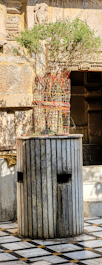Tulsi trees and temples within the fort at Jaisalmer
THE WALLS OF THE fort in Jaisalmer (Rajasthan) contain a living city that has been in existence since the early 18th century, but the fort itself was established in the 12th century. It is enjoyable to wander the narrow lanes that thread their way between houses, many of which are decorated with elaborate, Rajput style carving.
The only thing that can cause the visitor some concern is the regular passage of motorbikes and scooters along the thoroughfares which are severely limited in width. These vehicles, often driven by impatient people who sound the horn loudly and frequently, squeeze past one, narrowly avoiding injuring pedestrians. I suspect that these motorists find the tourists as irritating as the pedestrians regard them. That said, like Venice, whose main thoroughfares are crammed with visitors, Jaisalmer, like Venice, has byways that are almost deserted apart from the few residents who dwell in the houses lining them.
 A tulsi tree
A tulsi tree Today, we made a second visit to the fort and tried to avoid the busiest lanes as much as possible. In so doing, we stumbled across two lovely old mandirs (Hindu temples). Both were constructed in the 15th century, long before the fort became a residential area for civilians.
Both mandirs are still used for worship. In one of them, the Laxmi Narayan mandir, two pandits (priests) were having a heated argument yelling at each other across the courtyard. At this mandir, there was a tulsi (holy basil) tree, growing in a container, which has small alcoves in which lighted diyas (oil lamps) can be placed. I watched a man walking clockwise around the tulsi tree several times. When he had done this, he plucked one of its leaves and touched it reverently against his forehead.
The tulsi tree is of religious significance to devout Hindus. I read somewhere that when the Portuguese were occupying Goa and trying to encourage people to become Roman Catholic, tulsi trees were outlawed in that former colony.
The courtyard of the Laxmi Narayan was partly shaded by a peepal tree, whose leaves are heart shaped. Like the tulsi tree, the much larger peepal tree is also of religious significance.
The other old temple, which is smaller than it’s neighbour (Laxmi Narayan), is called the Ratneshwar Mahadev. I did not notice any tulsi plants associated with it. However, a peepal was growing next to it.
Although both mandirs had visitors, both locals and tourists, they were less crowded than the much-visited Jain temple with the fort. When we walked past it yesterday, it was literally swarming with tourists.
Apart from the spectacular array of finely decorated buildings that can be seen, what makes the fort of Jaisalmer well worth seeing is that it is still home people who live their everyday domestic lives there. Interspersed amongst the many things designed to appeal to tourists, one catches frequent glimpses of local people living their daily lives.



